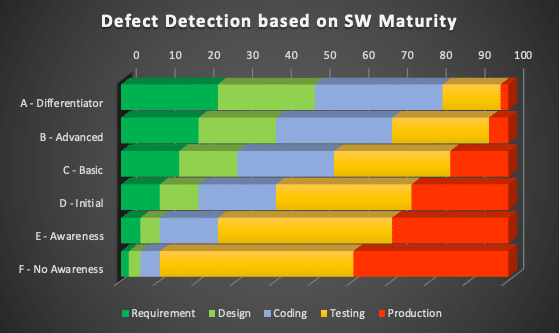In 2016, Philips, a leading global technology company, faced a substantial challenge due to the diverse software landscape resulting from multiple acquisitions and engineering teams spread worldwide. To address this, Philips established a Software Center of Excellence and implemented a methodology for software excellence, which standardized software practices, monitored performance, and drove improvements across the organization.

Reduction in Defects Annually
Million in Savings
Defects Avoided Annually
The Challenge
At the time, Philips had approximately 100,000 employees, with 5,000 engaged in software development across various product lines. As a result of rapid growth from acquisitions, the company had many engineering teams hailing from multiple countries and companies, each with its own software culture, tools, processes, and capabilities.
On top of that, the company delivered a wide range of products and services, including household appliances, medical devices, and advanced IT software for healthcare management.
Considering the diversity of the software team as well as the software landscape in terms of technologies, tools, and processes, the company sought to create a framework enabling the executive team to monitor and benchmark software practices globally. The objective was to establish consistent standards, identify and share best practices, and facilitate continuous improvement across the organisation.
The Solution
In early 2017, we established the first version of the Software Center of Excellence and developed a methodology to track, improve, and monitor software excellence. This later evolved to form the base of BetterSoftware’s current methodology and framework. Extensive visits to engineering sites worldwide were conducted to introduce the methodology, provide training, and assess the starting point for the organization.
The BetterSoftware.dev methodology gained widespread internal engagement and support at Philips. Internal forums were established to encourage the sharing of best practices and drive improvements in software craftsmanship. Key Performance Indicators (KPIs) were developed to monitor software practices and were regularly presented to Philips’ CTO and quarterly to the executive committee. These KPIs also served as program management tools to control the evolution of software practices across the entire organization.

Methodology Implementation and Reception
The methodology significantly improved Philips’ software practices by establishing a clear link between improvement efforts and a reduction in defects found during testing, verification, and at customer premises. Utilizing internal talent for organic improvement resulted in an average 10-point increase on the maturity scale, translating to a 10% reduction in defects per year for product releases. For a corporation managing hundreds of programs, each generating thousands of defects annually, this improvement resulted in substantial cost reductions.
Impact and Results
Over two years, the BetterSoftware Framework helped Philips achieve a quantifiable reduction of 9-12% in the number of defects generated in product releases annually. This improvement was directly tied to significant cost savings. Philips avoided over 5,000 defects per year and detected an additional 50,000 defects earlier in the software development lifecycle. This led to substantial financial savings, enhanced customer satisfaction, and improved quality of deliverables.
- Year 1 savings: $46.4 million (50,000 defects x $928 savings per defect)
- Year 2 savings: $41.7 million (45,000 defects x $928 savings per defect)
- Cumulative savings over two years: $88.1 million
The savings enabled Philips to deliver faster to customers with higher confidence, reduce customer escalations, and increase capacity to deliver more features at higher quality. This success underscores the importance of the BetterSoftware methodology in achieving software excellence across large, globally distributed organizations.
Cost Savings Analysis
The cost of a software bug varies depending on when it is detected in the software development lifecycle. The BetterSoftware Framework reduced costs by improving defect detection and prevention at Philips:
- Category E maturity: $3,690 per defect
- Category D maturity: $3,045 per defect
- Category C maturity: $1,975 per defect
- Category B maturity: $905 per defect
Moving from one category of maturity to a higher one saved, on average, $928 per defect. This progression illustrates the financial benefits of implementing a robust software maturity framework.

The BetterSoftware Framwrok has proven to be a game-changer in the software development process for large, globally distributed organizations like Philips. By standardizing practices and driving continuous improvement, Philips achieved significant financial savings, enhanced product quality, and greater customer satisfaction. This case study highlights the transformative impact of adopting a structured approach to software excellence.





